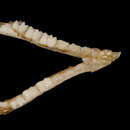Biology
(
Anglèis
)
fornì da Arkive
This insect-eating bat catches its prey on the wing, using an echolocation call that sweeps from a very high frequency (178 kHz) to a much lower one (58 kHz), and is repeated extremely rapidly. Its wing shape is perfect for a high degree of control in flight, making the bat relatively slow but highly manoeuvrable amongst the vegetation (2).
Breeding occurs all year round and, like most bat species, the mother gives birth to a single pup, which weighs around a quarter of her weight. At the beginning of its life, the pup clings to its mother's belly as she forages but is soon able to fly alongside her and catch its own prey. After just one year, the young clear-winged woolly bats are able to breed (4).
Conservation
(
Anglèis
)
fornì da Arkive
Deforestation for agriculture, particularly for oil palm plantations in recent years in Malaysia, Indonesia and Thailand, is an issue of major concern for many forest-dwelling species, even within so-called protected areas. Regarding oil palm, some companies and large retailers have agreed to source palm oil from sustainable sources via a certification process developed by the Roundtable for Sustainable Palm Oil. The principal criterion relevant to biodiversity is that new plantations have not been established on land of High Conservation Value (5). Many scientific and charitable groups contribute to bat monitoring and local education programmes that can help to reduce persecution and raise awareness of the natural assets of the land (4).
Description
(
Anglèis
)
fornì da Arkive
Aptly named, the clear-winged woolly bat is identifiable by its translucent wings. Its fur is very long and fluffy, ranging in colour from pale grey to dark brown, and fading to near white on the underside. The muzzle, has no noseleaf, the ears are usually a strong pinkish-yellow colour, and the teeth are sharp (2).
Habitat
(
Anglèis
)
fornì da Arkive
The clear-winged woolly bat is found in the understorey and lower canopy of rainforest. It appears to roost in dead leaves in small groups that have close social bonds (2).
Range
(
Anglèis
)
fornì da Arkive
This species is found in Peninsular Malaysia, Sumatra, Java, Borneo and the Philippines (3).
Status
(
Anglèis
)
fornì da Arkive
Classified as Lower Risk / Least Concern (LR/lc) on the IUCN Red List (1).
Threats
(
Anglèis
)
fornì da Arkive
Deforestation and forest fragmentation pose the greatest threat to the clear-winged woolly bat. The rapid increase in land devoted to commodity agriculture (such as cocoa, coffee, oil palm, rice and rubber) has resulted in extensive loss of forest in the last 20 years. In recent years, one of the largest agricultural drivers of deforestation in Malaysia, Sumatra and Thailand has been oil palm. Together, Malaysia and Indonesia export 88 percent of the world's palm oil, for use in products such as margarine, lipstick and detergent. In addition, despite the contribution of many bats in the control of insect crop pests, persecution of bats is also a threat (5) (6).

